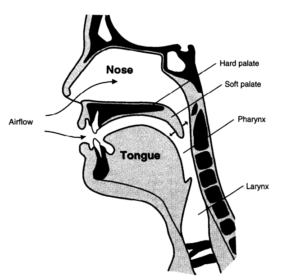Here we take a deeper look about that noise that plagues some of our family members, our roommates…or even ourselves!

What Causes You to Snore in the First Place?
The human upper airway contains anatomical parts that are membranous, meaning they lack support from cartilage. Some parts include the tongue, the soft palate, and the tonsillar pillars. A lack of cartilaginous support enables these parts of the airway to be susceptible to vibrations.
During sleep the upper airway muscles relax and cause the size of the airway space to decrease, resulting in airflow limitation and turbulence.
Whenever we inhale, the turbulent flow through the relaxed airway causes those membranous structures to vibrate and produce a sound most commonly known as snoring.
A Brief Mechanical Explanation of Snoring
Examining snoring in the view of mechanical systems, respiratory noise is created by the oscillation of the upper airway with the air passing through it. This oscillation is indicative of an issue with flow instability (turbulent flow) over a flexible structure (the relaxed airway).
An experiment was created to model the movement of the soft palate during snoring, where a piece of wood was used to simulate the hard palate and a piece of leather simulated the soft palate. The leather and wood were attached to each other inside of a rigid tube that was connected to a pump (meant to model the lung inspiration).
During inspiration, the leather flap oscillated until it reached its full amplitude. Upon reaching the maximum amplitude, the leather flap hit the wall of the tube and created a noise known as palatal “flutter”. This palatal flutter is the most common method of noise production in humans: snoring.
Is Snoring Something to Be Concerned About?

Approximately 44% of men and 28% of women are habitual snorers.
Snoring can be a symptom of obstructive sleep apnea, a condition distinguished by snoring and breathing that is labored by repetitive and obstructive gasps.
The fragmented sleep resulting from sleep apnea can lead to decreased energy and poor attention and concentration. Sleep apnea can also be related to vascular issues like hypertension and its prevalence appears to increase in people over 65 years of age.
What Are Some Remedies to Snoring?
Remedies for snoring range from noninvasive devices to invasive surgical procedures.
The surgical option to remedy snoring involves removing a portion of the vibratory tissue from the back of the upper airway. For those people wanting to avoid surgery, non-invasive solutions include the use of nasal strips to lift and open the nasal passages; experimenting with sleep positions other than sleeping on the back; or using oral appliances and nasal continuous positive airway pressure (nCPAP) to prevent the tongue and soft palate from collapsing into the upper airway. Losing weight, avoiding smoking and alcohol can also help to reduce snoring.
There are also resources for snoring in kids, as well as additional home remedies and surgical information regarding snoring.
Below is a great animated video which gives an introductory explanation to snoring.
Featured image by Kinga Howard on Unsplash

